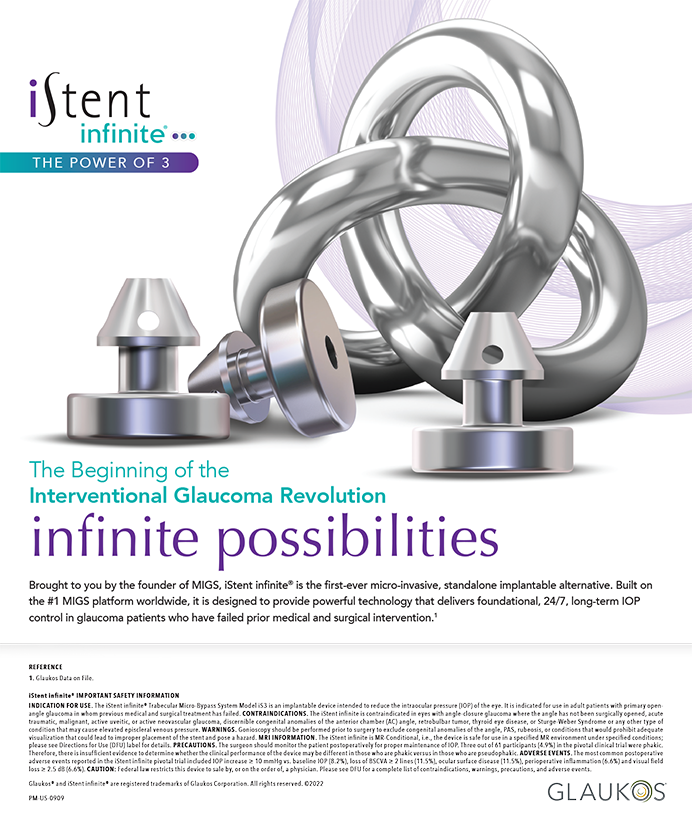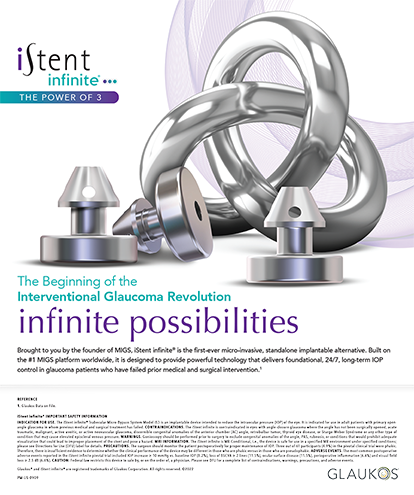Toxic anterior segment syndrome (TASS) is an acute, sterile, postoperative anterior segment inflammation that may occur following any anterior segment surgery.1 The hallmark of TASS is an inflammatory reaction in the anterior segment of the eye that starts within 12 to 48 hours after surgery. The most common clinical findings in these patients are (1) diffuse, limbus-to-limbus corneal edema (Figure 1), (2) increased inflammation in the anterior chamber with the possible formation of a hypopyon (Figure 2), and (3) the deposition of fibrin.2,3 The eye may also have a dilated pupil with an irregularity to the iris (Figure 3) and potential damage to the trabecular meshwork with subsequent secondary glaucoma. The inflammation is sterile and must be distinguished from an infectious endophthalmitis. This article summarizes the causes of, responses to, and prevention of TASS and provides information on the resources available to affected surgeons and centers.
THE CAUSES OF TASS
Cases of TASS may occur singly or, more often, in groups or clusters. The potential factors in the etiology of the condition are widespread.3-7 TASS may be due to problems with irrigating or balanced salt solutions or any medication, including antibiotics and analgesic agents that are injected into the eye during surgery. Topical drops or ointments that gain access to the anterior chamber may trigger an inflammatory reaction. In addition, any enzymes or detergents used to clean instruments or cannulas between cases are potential sources of postoperative inflammation. Contamination with a heat-stable endotoxin can occur from multiple different sources involved in the cleaning and sterilization of instruments and handpieces. Lastly, any residual material such as ophthalmic viscosurgical devices, cortex, or cleaning materials that remain in handpieces or cannulas can cause TASS.
AN ANALYSIS OF TASS
Once an outbreak of TASS has been recognized, it is important for all members of the surgical team to work together on its analysis. The effort should include not only the physicians involved but also the surgical nurses, OR technicians, and anyone participating in the preparation of the medications or solutions used in anterior segment surgery. In addition, staff members responsible for the cleaning and maintenance of autoclaves and ultrasound baths should participate.
The surgeons and representatives from the surgical center or hospital (including all involved nursing staff and personnel) should undertake a complete review of all OR protocols. They should carefully evaluate the procedures used in the sterilization and preparation of instruments in order to rule out any potential source of TASS. A complete analysis of all medications or fluids used during anterior segment surgery is also necessary. It is helpful to appoint a coordinator from the surgical center to oversee the review of the factors possibly involved in TASS.
It is beneficial to establish flowcharts and follow protocols to track changes or factors that could be responsible for the outbreak. Investigators should carefully evaluate any fluids, solutions, or medications used during the surgery and record all involved lot and batch numbers for potential etiologic agents.
THE PREVENTION OF TASS
Several steps can help prevent additional cases of TASS from occurring. All staff involved in the cleaning and sterilization of intraocular instruments should receive thorough instruction regarding the protocols for these processes. This effort can result in the elimination of residue that could accumulate on reusable instruments and cause a toxic reaction. The center should limit the use of such instruments and rely on disposable products, especially cannulas, when possible to eliminate a potential source of TASS. Instruments that need to be reused (eg, phaco and I/A handpieces) should be thoroughly rinsed at the conclusion of each case with at least 120mL of sterile, deionized water through both their irrigation and aspiration ports. The staff should replace the fluid on a daily basis in any ultrasound or water baths used to clean instruments in order to limit the possible growth of gram-negative bacteria, which may lead to a buildup of heat-stable lipopolysaccaride endotoxins. In addition, the staff should regularly clean the inside of these baths thoroughly.
Changing the water reservoir of steam autoclave sterilizers, when applicable, on a weekly basis will prevent the buildup of gram-negative bacteria with lipopolysaccaride endotoxins. In addition, the staff should thoroughly clean the inside of the autoclave at least once a week in order to prevent the accumulation of any potentially toxic, residual material.
Other possible sources of TASS include medications or solutions used within the eye. The surgeon and staff should carefully review all of the medications that are used during routine anterior segment surgery. They must ensure that medications are indeed free of preservatives if they are supposed to be. It is important that the epinephrine in the irrigating solution be without bisulphate preservatives. Anesthetic medicines such as intracameral lidocaine should also be noted to be free of preservatives, because even low levels within the anterior chamber of the eye can trigger an inflammatory reaction. Lastly, the surgeon and staff should take great care to ensure that any antibiotics or similar medications, either in the irrigating solution or injected into the eye at the conclusion of the case, are in the proper doses.
THE RESOURCES AVAILABLE
Attempting to analyze the source of a potential TASS outbreak can be difficult for a surgeon or surgical center. Outside help is available to assist in the analysis of a potential occurrence of TASS. The ASCRS has helped to establish the Intermountain Ocular Research Center, for which I am the director, at the University of Utah in Salt Lake City to evaluate the causes and prevention of TASS (see Helping to Prevent TASS). Protocols developed at the center can help guide this analysis, and ophthalmic research fellows are available to provide an on-site analysis of TASS outbreaks if necessary. Henry Edelhauser, PhD, has also established a response team at the Emory University Eye Center to provide assistance in the evaluation and prevention of outbreaks of TASS.
Both centers have worked with the Centers for Disease Control and Prevention as well as the FDA in the analysis of possible TASS outbreaks. Physicians and surgical centers may consider both of these centers as resources to help investigate incidents of TASS in order to track down the etiologic agents involved and help eliminate the potential sources of this sterile, postoperative inflammation.
Nick Mamalis, MD, is Professor of Ophthalmology at the John A. Moran Eye Center, University of Utah, Salt Lake City. Dr. Mamalis may be reached at (801) 581-6586; nick.mamalis@hsc.utah.edu.


